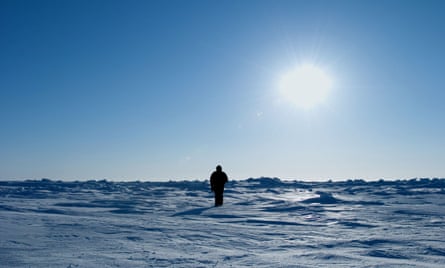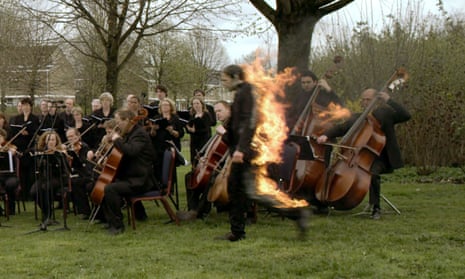When I called the artist Guido van der Werve last year to arrange a meeting, Pauline Portrait, his studio manager, told me he was recovering from a serious bicycle accident. I met with Van der Werve some months later in his studio in Prenzlauerberg, Berlin, and talked about his work as a film-maker, and the aftermath of the accident. It had been a close call – doctors said it was only his very strong constitution, built up through marathons and triathlons, that had got him through. You could say he had been saved by art.
For more than a decade Van der Werve, now 40, has been making films based on extreme physical endurance and skill, involving climbing, cycling, swimming and running. He combines these with music that he composes, and often performs, paying tribute to the Romantic composers he admires. He is by his own admission a romantic, but a rather mad one, undercutting the existential seriousness of his work with an offbeat humour often veering into absurdity.
We sit around a computer screen and watch one of his first films, Nummer Twee, Just Because I’m Standing Here Doesn’t Mean I Want To (all his works are numbered in Dutch and subtitled in English), made in 2003 while he was a student at the Gerrit Rietveld Academie in Amsterdam. It shows Van der Werve walking backwards into the suburban street in front of his childhood home, before being knocked down with some force by a car. Ballerinas appear from the back of a police van and dance around his inert body to Corelli’s Christmas Concerto.

“It was very strange, considering what has happened,” Van der Werve says grinning, typically deadpan. He wore protection on his leg, he explains, and consulted a stuntman, who told him to lean away from the car, putting his weight on the other leg – that way he would bounce over it rather than getting dragged under.
Van der Werve is not the first artist to subject himself to often violent physical testing in the name of art, using his own body as an artistic medium. During the 1970s the American artist Chris Burden had himself shot with a .22 calibre rifle, and nailed to the bonnet of a Volkswagen. The Dutch artist Bas Jan Ader was lost at sea in 1975, trying to cross the Atlantic in a tiny one-man vessel. But no other artist has pursued the idea with such a sense of the epic.
For Nummer Negen, the Day I Didn’t Turn With the World (2007) Van der Werve stood still for 24 hours on the geographical north pole, shuffling slowly, rotating in a circle as the world revolved the other way – anticlockwise – beneath him. The film is shot in timelapse, compressed into eight minutes or so, showing him jerking about, trying to keep warm. He used the same methods as the guards at Buckingham Palace, he says, and listened to audiobooks to help beat the boredom.

Even more spectacular was his Nummer Acht, Everything Is Going to Be Alright, in which he was filmed walking alone on sea ice in the northernmost part of the Baltic Sea, followed by a vast ship, breaking through the ice with a terrible creaking and shattering sound. Nummer Acht was the performance art equivalent of Caspar David Friedrich, updated for an age of environmental apocalypse.
Art is always in some way about testing limits, risking failure. For Nummer Dertien, Emotional Poverty in Three Effugium Van der Werve attempted to climb Mount Aconcagua in Argentina, as a prelude to climbing Mount Everest – for art. “I almost died,” he says, “it was just very hard and I found myself at a height where human beings shouldn’t be in the first place.” He decided not to climb Everest after all.
In another film he runs for 12 hours around the holiday house he and the artist Johanna Ketola, his girlfriend, own in Finland. The film is one shot lasting 12 hours. “Some guy in New York watched the film all the way through,” he says, both impressed and bemused. We fast forward to the final few minutes, where he disappears behind the house for a long time, before emerging slowly, dragging his legs. Another epic run is the “ultra-marathon” he has completed annually since 2010, 33 miles from New York City up to Rachmaninov’s grave in the small upstate town of Valhalla. He carries a bunch of chamomiles – the national flower of Russia, he explains – to place in tribute.

Last year’s run was cancelled, naturally, but he hopes to be fit enough to restart the tradition next year. “We’re really focused on the present moment,” Ketola says, sitting close by, “our sense of time has changed.” A couple of months ago, she adds, they ran 10km for the first time since the accident. He clocks up 100km daily on the fixed bike he rides in the studio, he tells me, on whose frame he has inscribed, in English, a version he once read of Chopin’s last words: “I don’t feel the pain any more.”
Van der Werve’s obsession with Chopin – the master, as he puts it, of abstracting emotion into the 12 notes of the scale – is at the heart of his 2012 film Nummer Veertien: Home. It is his most complicated film to date, involving a 1,000 mile triathlon, swimming, cycling and running from Warsaw, where Chopin’s heart is preserved, to Père Lachaise cemetery in Paris, where his body is buried. Chopin left Poland at the age of 20 for a musical tour and never returned: he died in Paris aged 38. His sister, fulfilling his will, had the grisly task of transporting his heart back to the land of his birth.
Van der Werve intertwines his “Chopin Heart and Body” triathlon with scenes based on memories of his own childhood in the Netherlands, as well as a narrative about Alexander the Great, shot in locations on the campaign that took the Macedonian leader to the Beas River in the Punjab, where in 326BC he was forced to turn back, dying in Babylon before he reached home. The structure for the film is provided by the 12 sections of the requiem Van der Werve composed for it, performed by an orchestra and choir who pop up at various locations throughout the film.
The mood is one of melancholy and existential striving, leavened by a strong sense of the absurd. The film opens with Van der Werve, in wetsuit and goggles, playing the opening bars of his composition on a piano in the Church of the Holy Cross in Warsaw. The orchestra pick up the theme, and he wanders out to begin his epic journey, swimming off down the Vistula.
In a later movement the orchestra, playing in a park, remain indifferent as Van der Werve walks by on fire. He returns to his family home to find it crammed with the musicians, and is then winched and dangled, like a figure in a Magritte painting, in the air over the roof by a crane. His mother and girlfriend meet him along the way, helping him on and off the triathlon bike, looking helpless in the face of his obsessive quest. He finally arrives exhausted at the church of La Madeleine in Paris, taking a seat to listen to the final act of his requiem, before hobbling to Chopin’s grave.
It is a madly romantic film, and I’m one of many viewers who have found it difficult not to be seduced. The intensely personal nature of the quest, the strange and often bizarre scenarios, and Van der Werve’s strangely self-effacing presence spool you in. The subject is the idea of home, and not being able to get there, but also the desolate scenery of the northern plains of Europe: the riverscapes and roadscapes, postwar housing estates and industrial buildings that seem so characterless compared with the romance and heroism of the past, the lives and stories of Chopin and Alexander the Great. The theme of exile, journeys and historical reminiscence bring Nummer Veertien into the orbit of the writings of WG Sebald, whose books such as The Rings of Saturn and Austerlitz have a similar combination of the melancholy and the strange.

We watch some of Van der Werve’s most recent film, Nummer Zestien, the Present Moment. It is the first of his films shot in a studio, and in which he does not appear, featuring rather groups of people, some of them unclothed, instructed by a mindfulness therapist and a Dutch porn film director. The film progresses slowly in 12 parts, each determined in some way by an astrological sign, and accompanied by music Van der Werve has written for pianola. It is strange and disconcerting, a bleak vision of human life reduced to pure mechanism. The work was made in response to his father’s death in 2013. As with his sports-based works, he says, it was an act of therapy. Van der Werve is less sure if it was at all effective – it at least got rid of some frustrations, he says.
Before I leave, Van der Werve offers to play something on the piano. Pauline drifts in and stays a while as he sits to play Chopin’s Raindrop Prelude. He makes a great effort to concentrate, glancing up and down from hands to the music, clearly still suffering the physical after-effects of the accident. Yet he plays movingly well: the long slow ostinato middle section, the repeated low note, the drops of rain signifying, some say, the dead in the Polish-Russian war; and then the final sunshine modulation, the return to a major key and a feeling of optimism anew.

Comments (…)
Sign in or create your Guardian account to join the discussion